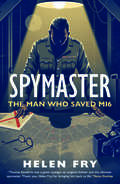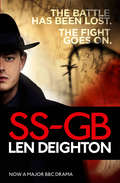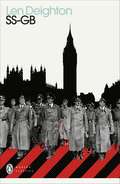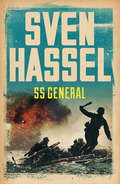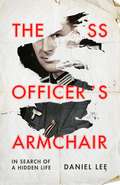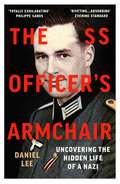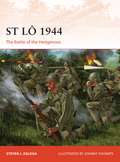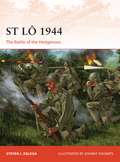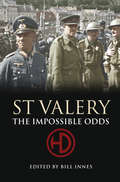- Table View
- List View
Spying in World War I: The true story of Margriet Ballegeer (General Military Ser.)
by Janet DeanIn 1914 Margriet Ballegeer, a young women from Contich, near Antwerp, joined the resistance in order to help sabotage the German occupation of Belgium throughout the war. Despite the danger, Margriet, aged only 24, joined the local resistance group and later became part of a wider network of spies run by the British Intelligence Service from Rotterdam. She stole identity papers and passports from the town hall where her father was Chief of Police, and using these, she was able to help young men escape Belgium and join the Allies. Margriet acted as a courier for the resistance group, using the cover of her shop to pass on messages and vital pieces of intelligence. First arrested in 1915 and charged with forging documents, Margriet spent six months in prison, but on her release remained committed to the cause, again joining a larger resistance group. In 1917, Margriet was arrested for a second time and interrogated by the Germans after being betrayed by one of their recruits. This time she was charged for spying and sentenced to death This is her story.
Spying in World War I: The true story of Margriet Ballegeer
by Janet DeanIn 1914 Margriet Ballegeer, a young women from Contich, near Antwerp, joined the resistance in order to help sabotage the German occupation of Belgium throughout the war. Despite the danger, Margriet, aged only 24, joined the local resistance group and later became part of a wider network of spies run by the British Intelligence Service from Rotterdam. She stole identity papers and passports from the town hall where her father was Chief of Police, and using these, she was able to help young men escape Belgium and join the Allies. Margriet acted as a courier for the resistance group, using the cover of her shop to pass on messages and vital pieces of intelligence. First arrested in 1915 and charged with forging documents, Margriet spent six months in prison, but on her release remained committed to the cause, again joining a larger resistance group. In 1917, Margriet was arrested for a second time and interrogated by the Germans after being betrayed by one of their recruits. This time she was charged for spying and sentenced to death This is her story.
Spymaster: The Man Who Saved MI6
by Helen FryThe dramatic story of a man who stood at the center of British intelligence operations, the ultimate spymaster of World War Two: Thomas Kendrick Thomas Kendrick (1881–1972) was central to the British Secret Service from its beginnings through to the Second World War. Under the guise of "British Passport Officer," he ran spy networks across Europe, facilitated the escape of Austrian Jews, and later went on to set up the "M Room," a listening operation which elicited information of the same significance and scope as Bletchley Park. Yet the work of Kendrick, and its full significance, remains largely unknown. Helen Fry draws on extensive original research to tell the story of this remarkable British intelligence officer. Kendrick’s life sheds light on the development of MI6 itself—he was one of the few men to serve Britain across three wars, two of which while working for the British Secret Service. Fry explores the private and public sides of Kendrick, revealing him to be the epitome of the "English gent"—easily able to charm those around him and scrupulously secretive.
The Spymaster of Baghdad: The Untold Story of the Elite Intelligence Cell that Turned the Tide against ISIS
by Margaret Coker'Pulse-pounding' Sinclair McKay | 'Truly masterful' Damien Lewis | 'Who needs spy fiction, when fact can provide as thrilling a story as this?' Lindsey HilsumThe Spymaster of Baghdad is the gripping story of the top-secret Iraqi intelligence unit that infiltrated the Islamic State. More so than that of any foreign power, the information they gathered turned the tide against the insurgency, paving the way to the killing of ISIS leader Abu Bakr al-Baghdadi in 2019.Against the backdrop of the most brutal conflict of recent decades, we chart the spymaster's struggle to develop the unit from scratch in challenging circumstances after the American invasion of Iraq in 2003, we follow the fraught relationship of two of his agents, the al-Sudani brothers - one undercover in ISIS for sixteen long months, the other his handler - and we track a disillusioned scientist as she turns bomb-maker, threatening the lives of thousands.With unprecedented access to characters on all sides, Pulitzer Prize-finalist Margaret Coker challenges the conventional view that Western coalition forces defeated ISIS and reveals a page-turning story of unlikely heroes, unbelievable courage and good old-fashioned spycraft.'Moving, visceral, utterly revelatory. A stunning tour de force by an author who has lived every word of it on the ground' Damien Lewis, author of Zero Six Bravo'This compelling account of how Iraqi agents infiltrated ISIS takes us deep beneath the lurid headlines and into a sharply focused world of courage, ingenuity, terror and love' Sinclair McKay, author of Dresden'In Margaret Coker's deeply reported, unputdownable account, the previously unknown Iraqi heros of the war against the Islamic State turn out to be braver than Bond and as subtle as Smiley' Lindsey Hilsum, author of In Extremis'We all owe a debt of gratitude to the Falcons Unit for their important role in the fight against the most lethal terrorist group of our time' Anne Speckhard, Director of the International Center for the Study of Violent Extremism
Spynest: British and German Espionage from Neutral Holland 1914–1918
by Edwin RuisAfter the First World War broke out, Holland, and the port city of Rotterdam in particular, became a prolific breeding ground for secret agents and spies. The neutrality of the Netherlands, its geographical position between the warring nations and its proximity to the Western Front meant that the British and German secret services both chose Holland as the main base for their pioneering spy operations. It was here that the new intelligence agencies fought their battles, each in pursuit of the other’s secrets. Both sides sent in their own agents, but they also hired local men and women to work for them, as couriers, trainspotters and infiltrators. Many of them were recruited from the shadowy criminal underworld and brought with them their own concerns; others sacrificed their lives for love of their country. Author Edwin Ruis has plumbed the depths of the international archives to bring to light the unexplored and often wellguarded secret histories of intelligence in the First World War. But even this is only half the story. Those who were not found out, the truly successful spies, remain a mystery to this day.
The Squad: And the Intelligence Operations of Michael Collins
by T. Ryle DwyerIn 1919, Michael Collins conceived of a scheme to knock out the eyes and ears of the British Administration at Dublin Castle by undermining and terrorising the police so that the British would react blindly and drive the Irish people to support of the Irish Republican Army. The Bureau of Military History interviewed those involved in this scheme in the early 1950s with the assurance that the material would not be published in their lifetimes. A few of the contributions were made available by the families of those involved, but the bulk of them have only recently been released. This is the first book to make use of those interviews. It makes fascinating, almost unique reading, because they contain first-hand descriptions in which men speak candidly of their involvement in killing selected people at close range. As a result it throws a considerable amount of new light on the activities of the Squad and the intelligence operations of Michael Collins.
Squaddie: A Soldier's Story
by Steven McLaughlinFrom the harsh realities of basic training to post-war chaos in Iraq and knife-edge tension in Northern Ireland, Squaddie takes us to a place not advertised in army recruitment brochures. It exposes the grim reality of everyday soldiering for the 'grunts on the ground'.After the tragic death of his brother, and in the dark days following 9/11, McLaughlin felt compelled to fulfil his lifelong ambition to serve in the army. He followed his late brother into the elite Royal Green Jackets and passed the arduous Combat Infantryman's Course at the age of 31. Thereafter, McLaughlin found himself submerged in a world of casual violence.Squaddie is a snapshot of infantry soldiering in the twenty-first century. It takes us into the heart of an ancient institution that is struggling to retain its tough traditions in a rapidly changing world. All of the fears and anxieties that the modern soldier carries as his burden are laid bare, as well as the occasional joys and triumphs that can make him feel like he is doing the best job in the world.This is an account of army life by someone who has been there and done it.
The Squire Quartet: Life In The West, Forgotten Life, Remembrance Day, And Somewhere East Of Life (The\squire Quartet #1)
by Brian AldissFor the first time ever, all four books in the Squire Quartet collected in one volume.
SR-71 Blackbird: 1964 Onwards (all Marks) (Combat Legends Ser. #20)
by Paul F CrickmoreLockheed's SR-71 Blackbird is one of the most iconic and famous jets ever built. Assembled in secret at Lockheed's Skunkworks, the Blackbird's vital statistics remain phenomenal decades later. It holds the airspeed record for a manned jet aircraft, operated at an altitude other aircraft could barely touch and was a marvel of technical engineering. Drawing on declassified material, leading SR-71 expert Paul Crickmore reveals the history of the most fascinating of aircraft, accompanied by a range of fantastic illustrations, photographs and facts about the world's most secret spy plane.
SR-71 Blackbird
by Paul F CrickmoreLockheed's SR-71 Blackbird is one of the most iconic and famous jets ever built. Assembled in secret at Lockheed's Skunkworks, the Blackbird's vital statistics remain phenomenal decades later. It holds the airspeed record for a manned jet aircraft, operated at an altitude other aircraft could barely touch and was a marvel of technical engineering. Drawing on declassified material, leading SR-71 expert Paul Crickmore reveals the history of the most fascinating of aircraft, accompanied by a range of fantastic illustrations, photographs and facts about the world's most secret spy plane.
The SS: A New History
by Adrian WealeThe SS was one of the most important institutions of Third Reich Germany, yet it is also among the least well understood. From the end of 1935, the SS had control over all police and internal security duties in Germany and the militarised Waffen SS had more than eight hundred thousand men serving in the field, in direct rivalry with the traditional German armed forces, the Wehrmacht.Making use of material not previously available, this definitive book refocuses attention on and enhances understanding of the hard-nosed political fanatics and opportunists who were responsible for one of the most appalling crimes in human history, the attempted execution of the Jews of Europe.
SS-GB: Nazi-occupied Britain, 1941 / Len Deighton
by Len DeightonIn February 1941 British Command surrendered to the Nazis. Churchill has been executed, the King is in the Tower and the SS are in Whitehall…
SS-GB (Penguin Modern Classics)
by Len Deighton'Deighton's best book ... an absorbingly exciting spy story that is also a fascinating exercise in might-have-been speculation' The New York Times Book ReviewIt is 1941 and Germany has won the war. Britain is occupied, Churchill executed and the King imprisoned in the Tower of London. At Scotland Yard, Detective Inspector Archer tries to do his job and keep his head down. But when a body is found in a Mayfair flat, what at first appears to be a routine murder investigation sends him into a world of espionage, deceit and betrayal.'Len Deighton is the Flaubert of contemporary thriller writers ... this is much the way things would have turned out if the Germans had won' The Times Literary Supplement
SS General (Sven Hassel War Classics)
by Sven HasselSS GENERAL is the definitive Stalingrad novel, a gripping portrait of war's brutal realities.It was said that Stalingrad had been burning since August, ever since the first German bombs were dropped...Sven Hassel and his comrades are plunged into the maelstrom of Stalingrad. Radio Moscow reports that one German soldier dies every minute. Trapped by the Russian counter-attack, starving soldiers must resort to cannibalism to survive. But 'Tiny', Porta, the Legionnaire and Sven attempt to break out, to fight their way across the frozen steppe.Their leader: an SS general who takes no prisoners...
The SS of Treblinka
by Ian BaxterIn January 1942 senior officials of the Nazi regime met to discuss the ‘final solution to the Jewish question’, at a gathering that became known as the Wannsee Conference. As part of the resulting Operation Reinhard, camps were built with one aim in mind, not to imprison the Jews, but to kill them. By the time the extermination camp of Treblinka was made fully operational in July 1942, the SS had built a killing factory capable of despatching hundreds of thousands of people which could be run by only a handful of guards. But who were these men who ran Treblinka, many of whom had volunteered for the job? Were they ordinary people following terrible orders, or were they monsters? In The SS of Treblinka, Ian Baxter reveals the true natures of the men who during the camp’s short operation, murdered some 850,000 Jews. Some of them appeared outwardly to have been kind family men who then inflicted terrible cruelties on those in their power, while a few were afterwards spoken about with affection and gratitude by survivors. Using official documents, trial transcripts and private correspondence, he describes how these men lived day to day, inured to scenes of tragedy, eating and drinking the provisions their victims had brought with them under the delusion that they would be resettled, and what they thought of the thousands of people who arrived at the rail station positioned only metres from the gas chambers, whose bodies they would oversee being burned within the hour.
The SS Officer's Armchair: In Search of a Hidden Life
by Daniel LeeIt began with an armchair. It began with the surprise discovery of a stash of personal documents covered in swastikas sewn into its cushion. The SS Officer’s Armchair is the story of what happened next, as Daniel Lee follows the trail of cold calls, documents, coincidences and family secrets, to uncover the life of one Dr Robert Griesinger from Stuttgart. Who was he? What had his life been – and how had it ended?Lee reveals the strange life of a man whose ambition propelled him to become part of the Nazi machinery of terror. He discovers his unexpected ancestral roots, untold stories of SS life and family fragmentation. As Lee delves deeper, Griesinger’s responsibility as an active participant in Nazi crimes becomes clearer. Dr Robert Griesinger’s name is not infamous. But to understand the inner workings of the Third Reich, we need to know not just its leaders, but the ordinary Nazis who made up its ranks. Revealing how Griesinger’s choices reverberate into present-day Germany, and among descendants of perpetrators, Lee raises potent questions about blame, manipulation and responsibility. A historical detective story and a gripping account of one historian’s hunt for answers, The SS Officer’s Armchair is at once a unique addition to our understanding of Nazi Germany and a chilling reminder of how such regimes are made not by monsters, but by ordinary people.
The SS Officer's Armchair: In Search of a Hidden Life
by Daniel LeeIt began with an armchair. It began with the surprise discovery of a stash of personal documents covered in swastikas sewn into its cushion. The SS Officer’s Armchair is the story of what happened next, as Daniel Lee follows the trail of cold calls, documents, coincidences and family secrets, to uncover the life of one Dr Robert Griesinger from Stuttgart. Who was he? What had his life been – and how had it ended?Lee reveals the strange life of a man whose ambition propelled him to become part of the Nazi machinery of terror. He discovers his unexpected ancestral roots, untold stories of SS life and family fragmentation. As Lee delves deeper, Griesinger’s responsibility as an active participant in Nazi crimes becomes clearer. Dr Robert Griesinger’s name is not infamous. But to understand the inner workings of the Third Reich, we need to know not just its leaders, but the ordinary Nazis who made up its ranks. Revealing how Griesinger’s choices reverberate into present-day Germany, and among descendants of perpetrators, Lee raises potent questions about blame, manipulation and responsibility. A historical detective story and a gripping account of one historian’s hunt for answers, The SS Officer’s Armchair is at once a unique addition to our understanding of Nazi Germany and a chilling reminder of how such regimes are made not by monsters, but by ordinary people.
St Albans 1455: The Anatomy of a Battle
by Andrew BoardmanFor many years the first battle of St Albans was regarded as a ‘short scuffle in the street’. A.W. Boardman, the author of Towton 1461: The Anatomy of a Battle, proves this was not the case. Indeed, the battle was unique and a significant event in England’s medieval history.The street fighting was widespread, the town was pillaged in the aftermath, Henry VI was almost killed, and the battle’s political consequences proved so problematic for both sides that parliament used official propaganda to conceal the truth.St Albans was, along with other lesser-known battles of the early 1450s, the genesis of the Wars of the Roses, and it is probably the best-documented encounter of the period. The battle heralded the beginning of an intense blood feud that fuelled the civil wars between York and Lancaster for many generations. But what really happened in the streets of St Albans on 22 May 1455? What prompted Richard Duke of York and the Neville family to rebel against Henry VI? And who were the instigators of the conflict that caused the execution and deaths of a substantial portion of England’s nobility by the end of the fifteenth century?This book answers these questions and discusses the theories about St Albans following a detailed and multi-disciplined approach. A.W. Boardman reveals the anatomy of a battle hidden beneath the streets and alleyways of this modern city and explains the wider issues of the Wars of the Roses in northern England. Illustrated throughout with contemporary images, modern photographs and specially drawn battle maps, this new and fully updated edition is a thorough examination of the sources, the terrain and the military significance of the first battle of St Albans: a battle where the streets ran red with blood.
St Lô 1944: The Battle of the Hedgerows (Campaign)
by Steven J. Zaloga Johnny ShumateFollowing the D-Day landings on 6 June 1944, the First US Army engaged in a six-week struggle to break out of the Normandy beach-head. The hedgerow country of lower Normandy, called the Bocage, presented unanticipated tactical problems since it proved to be ideal for German infantry defense. This book examines the brutal attritional struggle in June-July 1944 to overcome the determined German defense and secure St Lô. The city was the site of a crucial cross-roads and was thus a vital target for the invading Allied forces; the initial bombing attacks were so severe that the journalist and poet Samuel Beckett would later report that it had been 'bombed out of existence in one night'. The attack by ground forces turned into a brutal attritional struggle to overcome the determined German defense. Using full-colour artwork, photographs and maps, this is the engaging story of one of the key engagements in the Battle of Normandy.
St Lô 1944: The Battle of the Hedgerows (Campaign)
by Steven J. Zaloga Johnny ShumateFollowing the D-Day landings on 6 June 1944, the First US Army engaged in a six-week struggle to break out of the Normandy beach-head. The hedgerow country of lower Normandy, called the Bocage, presented unanticipated tactical problems since it proved to be ideal for German infantry defense. This book examines the brutal attritional struggle in June-July 1944 to overcome the determined German defense and secure St Lô. The city was the site of a crucial cross-roads and was thus a vital target for the invading Allied forces; the initial bombing attacks were so severe that the journalist and poet Samuel Beckett would later report that it had been 'bombed out of existence in one night'. The attack by ground forces turned into a brutal attritional struggle to overcome the determined German defense. Using full-colour artwork, photographs and maps, this is the engaging story of one of the key engagements in the Battle of Normandy.
St Mihiel 1918: The American Expeditionary Forces’ trial by fire (Campaign)
by Howard Gerrard David BonkAt 1:00 am on September 12, 1918, accompanied by rain and lightning, the American Army launched its first major offensive of World War I. Supported by French Colonial troops, the American IV and V Corps burst through the weakened German line at St. Mihiel and seized numerous objectives while taking over 16,000 prisoners and capturing over 400 guns. Although American tactics remain suspect, and the operation cost 7,000 US casualties, the battle was heralded as a huge Allied victory. More importantly, it demonstrated to the French and British that the Americans were capable of large-scale, combined-arms operations. Packed with photos, artwork and battle maps, this book explains the entire offensive in detail.
St Mihiel 1918: The American Expeditionary Forces’ trial by fire (Campaign #238)
by Howard Gerrard David BonkAt 1:00 am on September 12, 1918, accompanied by rain and lightning, the American Army launched its first major offensive of World War I. Supported by French Colonial troops, the American IV and V Corps burst through the weakened German line at St. Mihiel and seized numerous objectives while taking over 16,000 prisoners and capturing over 400 guns. Although American tactics remain suspect, and the operation cost 7,000 US casualties, the battle was heralded as a huge Allied victory. More importantly, it demonstrated to the French and British that the Americans were capable of large-scale, combined-arms operations. Packed with photos, artwork and battle maps, this book explains the entire offensive in detail.
St Nazaire 1942: The Great Commando Raid (Campaign #92)
by Howard Gerrard Ken FordThe raid on the port of St Nazaire in March 1942 by a sea-borne task force from British Combined Operations remains one of the most daring actions of World War II. The port lies at the mouth of the River Loire and in 1942, as well as a U-Boat base, contained the massive 'Normandie' dock, the only facility on the Atlantic coast large enough to accommodate the German pocket battleship Tirpitz. This book tells the story of the raid on St Nazaire that denied the use of the dock to the Tirpitz, the sister ship of the Bismarck, and constituted a crucial victory in the Battle of the Atlantic.
St Nazaire 1942: The Great Commando Raid (Campaign #92)
by Howard Gerrard Ken FordThe raid on the port of St Nazaire in March 1942 by a sea-borne task force from British Combined Operations remains one of the most daring actions of World War II. The port lies at the mouth of the River Loire and in 1942, as well as a U-Boat base, contained the massive 'Normandie' dock, the only facility on the Atlantic coast large enough to accommodate the German pocket battleship Tirpitz. This book tells the story of the raid on St Nazaire that denied the use of the dock to the Tirpitz, the sister ship of the Bismarck, and constituted a crucial victory in the Battle of the Atlantic.
St Valery: The Impossible Odds
by Bill InnesExamines the fateful chain of events in 1940, and reassesses some of the myths that arose in the intervening years. This book includes accounts that present the chaos and horror of war and the grim deprivation of the camps and forced marches which so many endured. It contains stories that resound with the spirit, humour and sense of comradeship.


